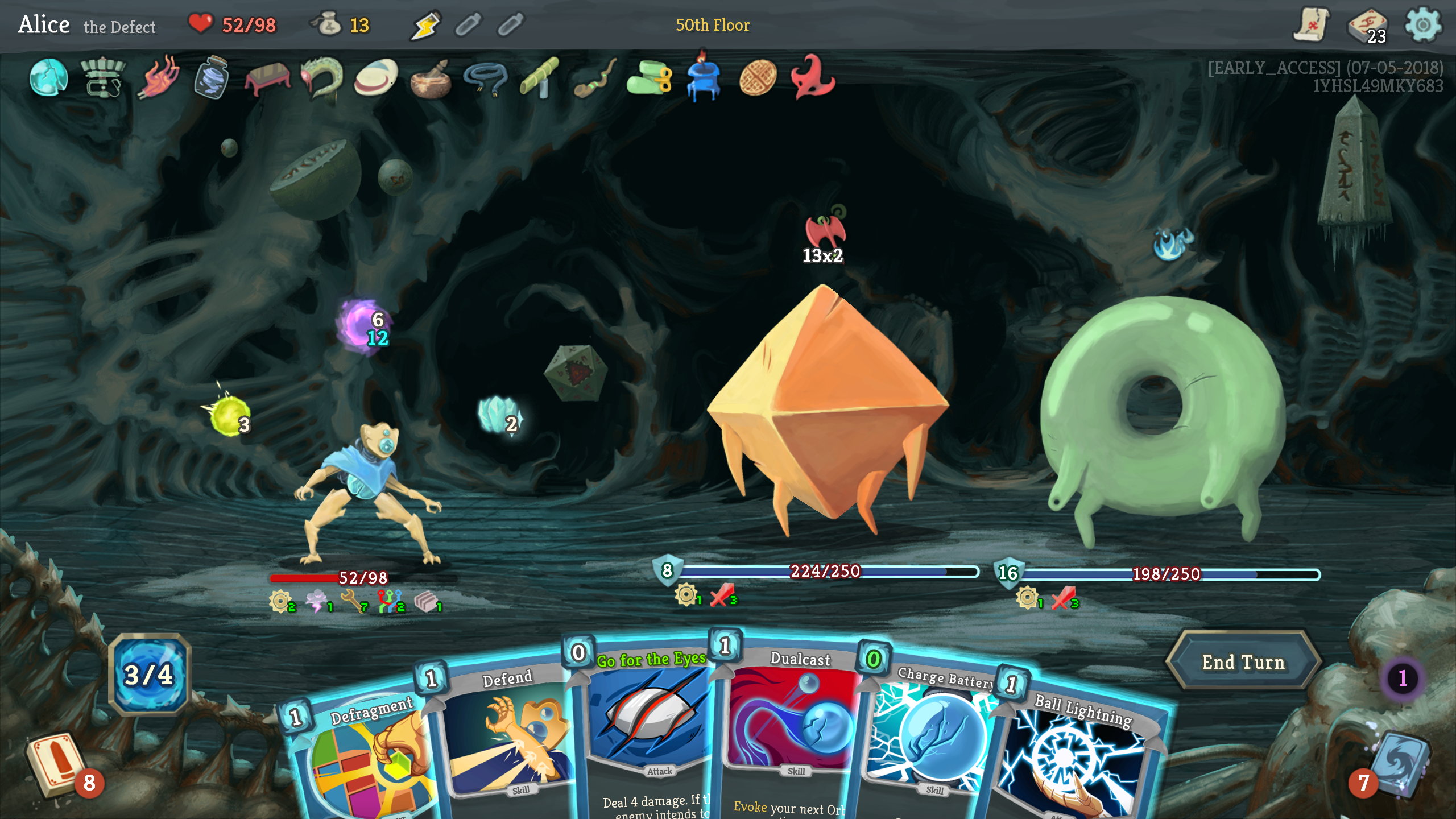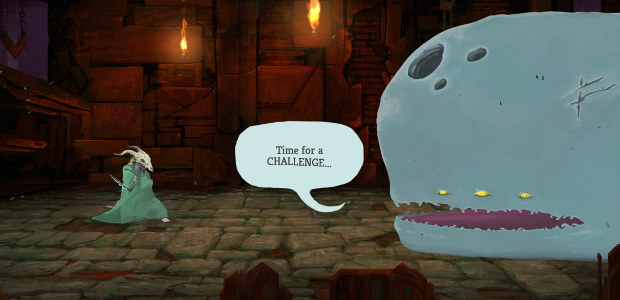Wot I Think: Slay The Spire
A miracle of design
It’s not often I get to play a game for 187 hours before reviewing it. Hell, it's not often I play a game for 187 hours. Deck-building, singleplayer roguelite Slay The Spire, which gets a full release today after just over a year in early access, has me on its hook.
Traditionally, I look at a number like that and hate myself – so much time wasted pursuing incremental item upgrades in an MMO or Diablolike, or, God help me, watching pretend numbers go eternally up in a clicker game. A number like that generally means I lost myself to something unhealthy, like a toddler set loose in a ball-pit full of popping candy. And so I snarl at myself in the mirror, and swear myself off such practices for life. Until the next time.
I look at those 187 hours in Slay The Spire and I don’t feel that way. I feel... pride? I think “all that time, and I’m still not tired of this wonderful toy. Do it again, do it again!”
Slay The Spire is a card game, but it is not a game about collecting cards, no Hearthstone or Magic. It is not the drug of compulsion - it is the drug of a gauntlet forever thrown upon the ground. It is a game about working with a set deck of hundreds, and steadily learning exactly how each of those cards is best used, in combination with what, at the expense of what, against what, or to be avoided if you have this or that other card or cards.
Each battle, against a series of randomly-selected beasties, cultists, floating monoliths, birdmen or one of several titanic bosses, is presented as one room in your bloody journey up the titular Spire. In time, you will come to recognise each of them on sight, have learned too well the nasty tricks up their sleeves, or nearest approximation of sleeves. Will know that any one of them could potentially end your journey, inflicting perma-death and necessitating a fresh start.
This is chess with a thousand different pieces, each lunatic and murderous and poisonous and strategy-nullifying in their own way, and very different from the moveable feasts of many other contemporaneous games of combat-cards. Spire was inspired by Netrunner, and it shows – its god is absolute balance at all times, not flavour of the month cards. There are no other cards to buy, to be clear: everything is self-contained, though a few cards must be unlocked through play before you might see them crop up in your randomly-allocated deck.
The difference between Slay The Spire and other such violently vampiric time-eaters is that it is not a game about chasing an ever-moving goalpost. Which is to say, a ceaseless stream of ephemeral rewards that make one feel more powerful for approximately 12 seconds, before the itchy hunger for another pointless prize takes hold anew. I play Slay The Spire in order to get better at playing Slay The Spire. To further build that mental encyclopedia of strategies and enemy patterns and card combinations.
I play Slay The Spire because I want to slay the Spire. If I fail to slay the spire - if I am beaten before I reach its final fight, and thus lose everything, all I want to do is try again. Don't waste that knowledge. I've won it time and again with each of its three, gloriously different playable characters/classes, and the ongoing lure of remixed daily challenges or tougher-still Ascension modes means there's no sense yet that my work is done. My work has only just begun.
Some quarter of my brain is now, and perhaps forever, a TV detective’s wall of spider-scribble post-it notes and vein-red string, connections and patterns and theories, forever seeking to finally decipher the puzzle that Slay The Spire presents to me. The puzzle of how to win. Not once, not twice, not even a hundred times – those, I have done. How to win every time. I am not sure I shall rest until I have solved this conundrum.
There are a handful of games I consider to be honest-to-God miracles of design. Spelunky and Into The Breach spring most readily to mind, alongside the inevitable Tetrises. My current dilemma, which is to say throughout the duration of writing this review, is whether or not to file Slay The Spire alongside them. I feel wretchedly anxious at the idea of ever having to make something like this – how would it ever be possible, to make all these pieces matter, nothing purposeless, nothing too purposeful, everything in some way essential?
Even the cards you begin any new run with, a simple Strike or Defend, perpetually serve a role – either a combination with something else, or their ongoing presence to keep you back from being overpowered, from not feeling the burn of undying challenge.
It’s so easy to get carried away praising Spire’s balance and design, how well-judged is its place on the line between difficult and satisfying, but I should spare some words for how good it looks and feels. A sort of mutant dark fantasy, rare is the time that one of Spire’s creatures is pedestrian. There are a few tropes here, but they’re always a little twisted, both in enemy appearance and the careful rule-twists they employ as they savage me.
Sometimes the beyond-scant writing has some jarring tonal shifts, jumping erratically from murderous menace to curt mystery to flat functionality to maniac humour, but I don't see those words any more. I see the creatures, and everything I've learned from them.
My daughter watches me play Spire with unsettling frequency, and she’s fascinated by the dead rats with fungal eruptions from their stomachs, from the implications of what face is under that hood, why those giant geometric shapes fight. It reminds me of youthful experiences with Advanced Dungeons & Dragons, before that particular bestiary became too familiar – questions, questions, questions.
For her, at least. Me, I greet each returned foe as an old friend. I know their likes and dislikes. I know their game. I crack my knuckles and relish their challenge. I know them so well by now, that even if I meet them with only three remaining hitpoints to my name, I’m still in with a chance.
Or so I think, because I conveniently forget that this never, ever happens. Even after 187 hours, I die in ignominy far more often than I prevail. I don't know quite what it is that stops me from feeling crushed, when all my progress, all my cards, and most of all the strategies I've built across the course of this run, is or are lost forever, suddenly and brutally, my reward only a line of a cold mockery.
Maybe it's because Spire so rarely feels unfair, even when it pits me against some screen-high red git who can deal out four times as much damage as me. If I've made it that far without a strategy to cope, I've only myself to blame if it summarily clubs me to death and then eats up whatever brain-jam is left afterwards.
(My only exception here is the fight-before-last once you have unlocked Spire's fourth and final floor, a particularly punitive boss fight that is in its self survivable but which invariably leaves me in desperately poor health for the final, final fight. I feel it is unfair, but I only feel that now - in time, I expect, I'll have a dozen coping strategies).
Maybe it's because, on a new run, my new strategy makes itself known so quickly. Only a couple of rinse and repeat, hit and/or defend wars of dour attrition against fodder-foes before a win wins me a new (but familiar) card, one which sets the pace of the cards I'll choose across this course of this new campaign. A new post-it note for the wall, another red string. The game's afoot, again.
Or maybe it's because Slay The Spire is a drug.
A drug I don't want to quit. A miracle of design? Yeah, go on.















